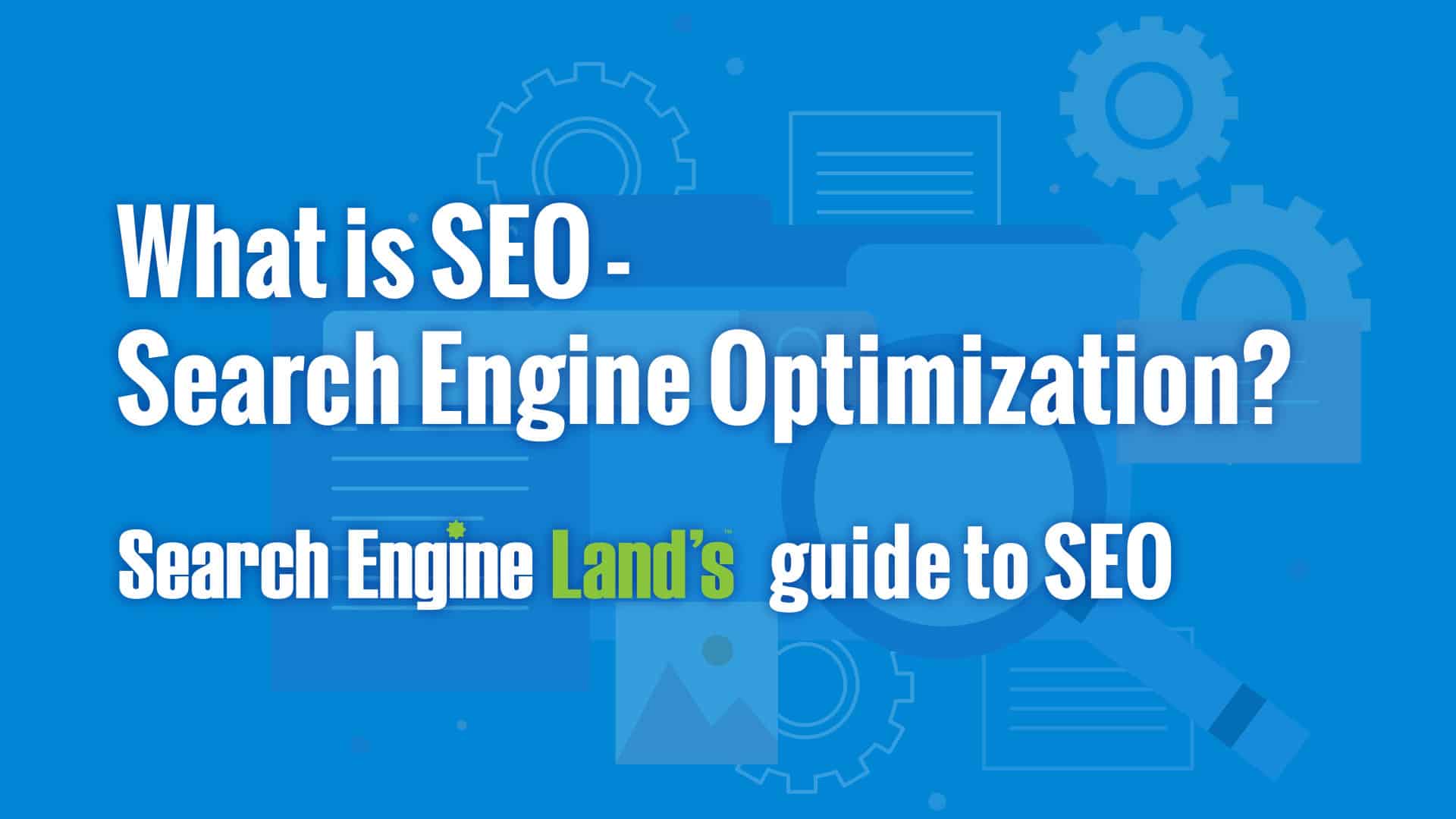The best search engine optimization title is clear, concise, and includes relevant keywords. It should capture attention and improve click-through rates.
Effective SEO titles are crucial for driving traffic to your website. They should be compelling and relevant to the content. Using primary keywords naturally within the title improves visibility on search engines. Keep the title under 60 characters to ensure it displays correctly in search results.
Incorporate power words to make the title more appealing. Consistency in style and format across your website helps build brand recognition. A well-crafted SEO title can significantly impact your site’s performance by attracting more visitors and enhancing user engagement. Writing engaging and precise titles is a key strategy in effective search engine optimization.

Credit: searchengineland.com
Keyword Research
Keyword research is essential for Search Engine Optimization (SEO). It helps you find terms your target audience searches for online. These terms, or keywords, are vital for your website’s visibility. Proper keyword research can increase traffic and improve your rankings on search engines. Let’s explore how to find the best keywords for your content.
Finding High-value Keywords
Finding high-value keywords is the first step. Use tools like Google Keyword Planner or Ahrefs to identify keywords with high search volume. These tools show how often people search for specific terms. Focus on keywords with high search volume and low competition.
Here’s a simple process to find high-value keywords:
- Identify your niche.
- Use keyword research tools.
- Look for high search volume.
- Check the competition level.
- Choose keywords with high volume and low competition.
Analyzing Competitor Keywords
Analyzing competitor keywords helps you understand what works. Use tools like SEMrush or SpyFu to see which keywords your competitors rank for. This gives you insight into their strategy.
Steps to analyze competitor keywords:
- Identify top competitors in your niche.
- Enter their URL in a keyword analysis tool.
- Review the list of keywords they rank for.
- Identify keywords with high potential.
- Incorporate these keywords into your content.
Below is a table summarizing the tools and their uses:
| Tool | Purpose |
|---|---|
| Google Keyword Planner | Find high search volume keywords |
| Ahrefs | Identify low competition keywords |
| SEMrush | Analyze competitor keywords |
| SpyFu | Get competitor keyword insights |
By following these steps, you can find and use valuable keywords. This improves your SEO and helps attract more visitors to your site.

Credit: moz.com
On-page Optimization
On-page optimization is crucial for improving your website’s visibility in search engines. It involves fine-tuning various elements within your web pages to rank higher and attract more organic traffic. Let’s dive into some essential aspects of on-page optimization.
Optimizing Meta Tags
Meta tags play a vital role in on-page SEO. They help search engines understand the content of your page. There are two main types of meta tags: the meta title and the meta description.
- Meta Title: This should be unique and include primary keywords. Aim for 50-60 characters.
- Meta Description: This should be compelling and include secondary keywords. Aim for 150-160 characters.
Here’s an example of effective meta tags:
Improving Url Structure
A clean and well-structured URL improves user experience and SEO. Use simple and descriptive URLs that include keywords.
| Good URL | Bad URL |
|---|---|
| example.com/seo-tips-2023 | example.com/index.php?id=123 |
Follow these tips for optimizing your URL structure:
- Keep URLs short and descriptive.
- Use hyphens to separate words.
- Avoid special characters and numbers.
- Include primary keywords in the URL.
Example of an optimized URL:
https://www.example.com/seo-strategies-for-2023
These practices will make your URLs more user-friendly and search-engine friendly.
Content Strategy
A strong content strategy is essential for effective SEO. It involves planning, creating, and managing high-quality content. The goal is to attract and engage your audience. Let’s explore key aspects of a successful content strategy.
Creating High-quality Content
High-quality content is crucial for your SEO efforts. It must provide value to your readers. This means it should be informative, engaging, and relevant. Here are some tips for creating such content:
- Understand your audience’s needs.
- Use clear and simple language.
- Incorporate visuals like images and videos.
- Ensure your content is error-free.
- Update your content regularly.
Using a combination of text, images, and videos can make your content more engaging. This keeps visitors on your site longer.
Using Lsi Keywords
Using Latent Semantic Indexing (LSI) keywords helps search engines understand your content better. LSI keywords are terms related to your main keyword. They provide context and improve your SEO. Here’s how to use them:
- Identify related keywords using tools like Google Keyword Planner.
- Incorporate these keywords naturally into your content.
- Avoid keyword stuffing, which can harm your SEO.
Using LSI keywords makes your content more relevant. It helps search engines rank your pages higher.
Here’s an example of using LSI keywords for the main keyword “SEO tips”:
| Main Keyword | LSI Keywords |
|---|---|
| SEO tips | search engine optimization tips, SEO strategies, improving SEO |
Incorporating these LSI keywords enhances your content’s relevance. This leads to better search engine rankings.

Credit: developers.google.com
Technical Seo
Technical SEO is the foundation of a successful SEO strategy. It ensures your website is well-structured for search engines. This helps in improving your site’s visibility and user experience. Below are crucial aspects of Technical SEO.
Improving Site Speed
Site speed is vital for both users and search engines. A fast-loading site keeps visitors engaged and reduces bounce rates. Use tools like Google PageSpeed Insights to analyze your site speed.
Here are some tips to improve your site speed:
- Optimize images by compressing them.
- Minimize CSS, JavaScript, and HTML files.
- Enable browser caching.
- Use a Content Delivery Network (CDN).
- Reduce server response time.
Use these tips to make your site faster and improve user experience.
Ensuring Mobile-friendliness
With more people using mobile devices, mobile-friendliness is essential. Google uses mobile-first indexing, meaning it ranks sites based on the mobile version. Test your site’s mobile-friendliness using Google’s Mobile-Friendly Test.
Follow these steps to ensure your site is mobile-friendly:
- Use a responsive design.
- Ensure easy navigation on small screens.
- Optimize touch elements for better usability.
- Compress images for faster loading.
- Ensure readable text without zooming.
These steps will help improve your mobile SEO and user experience.
Link Building
Link Building is an essential part of any successful Search Engine Optimization (SEO) strategy. It involves acquiring hyperlinks from other websites to your own. These links help search engines discover new web pages and determine how well a page should rank in their results. Effective link building can significantly improve your site’s visibility and credibility.
Earning Quality Backlinks
Quality backlinks are crucial for SEO success. These links come from authoritative sites, which signal to search engines that your content is trustworthy and valuable.
- Write high-quality, informative content that others want to link to.
- Guest post on reputable websites in your niche.
- Utilize social media platforms to share your content and attract backlinks.
- Engage with influencers who can link back to your site.
Focus on earning links from sites with high domain authority. Use tools like Moz or Ahrefs to check a site’s authority.
Avoiding Black-hat Techniques
Black-hat techniques may provide quick results, but they can harm your site in the long run. Search engines penalize sites using these tactics, which can lead to lower rankings or even removal from search results.
Here are some black-hat techniques to avoid:
- Buying links from link farms or low-quality sites.
- Using automated programs to create links.
- Participating in link exchange schemes.
- Creating hidden links on your website.
Instead, focus on building a strong link profile through ethical methods. This ensures sustainable growth and credibility for your website.
User Experience
User experience (UX) is crucial for SEO. A positive UX keeps visitors on your site. This helps improve search engine rankings. Focus on enhancing your site’s UX for better engagement.
Enhancing Site Navigation
Clear navigation helps users find what they need quickly. Use descriptive labels for menus. Create drop-down menus for subcategories. A search bar is essential for large sites. It helps users locate specific content easily.
| Navigation Tips | Benefits |
|---|---|
| Descriptive Labels | Improves user understanding |
| Drop-down Menus | Organizes subcategories |
| Search Bar | Finds content quickly |
Boosting Engagement Metrics
Engagement metrics show how users interact with your site. High engagement means users find your content valuable. Bounce rate is an important metric. Lower bounce rates indicate better user experience. Page views per session should also be high. This means users are exploring your content.
- Improve content readability: Use short sentences and simple words.
- Use images and videos: Visuals keep users engaged.
- Incorporate interactive elements: Quizzes, polls, and forms can boost engagement.
Internal linking is another key factor. It helps users navigate through your site. This increases the time spent on your site, boosting engagement metrics.
Analytics And Monitoring
Analytics and monitoring are crucial aspects of any successful SEO campaign. Understanding how your website performs and making data-driven decisions can significantly boost your search engine rankings. Let’s delve into the importance of tracking SEO performance and adjusting strategies based on data.
Tracking Seo Performance
Tracking your SEO performance helps you understand what works and what doesn’t. Use tools like Google Analytics and Google Search Console to monitor your website’s traffic and keyword performance.
- Google Analytics: Tracks user behavior on your site.
- Google Search Console: Provides data on keyword rankings.
Keep an eye on key metrics such as:
| Metric | Description |
|---|---|
| Organic Traffic | Number of visitors from search engines. |
| Keyword Rankings | Position of your keywords in search results. |
| Bounce Rate | Percentage of visitors who leave quickly. |
Regularly review these metrics to ensure your SEO strategy is on track.
Adjusting Strategies Based On Data
Data-driven decisions are key to optimizing your SEO efforts. Analyze the collected data to understand trends and patterns. If a keyword isn’t performing, consider optimizing your content or targeting a different keyword.
- Analyze the data: Look for trends and issues.
- Optimize content: Improve underperforming pages.
- Target new keywords: Find better opportunities.
Adjust your strategies based on the data insights. For example, if you notice high bounce rates, improve your content’s relevance or page loading speed.
Use A/B testing to find out which changes work best. Always rely on data to guide your SEO efforts.
Frequently Asked Questions
What Is The Best Seo Title?
The best SEO title is clear, concise, and includes the primary keyword. It should attract clicks and accurately describe the content.
What Is A Seo Friendly Title?
A SEO friendly title includes relevant keywords, is concise, and accurately describes the content. It attracts both search engines and readers.
How To Optimize Seo Title?
Use primary keywords at the beginning of the title. Keep it under 60 characters. Make it compelling and relevant. Avoid keyword stuffing. Ensure it matches the content.
What Is The Best Title Size For Seo?
The best title size for SEO is typically between 50-60 characters. This ensures readability and avoids truncation in search results.
What Is Seo?
SEO stands for Search Engine Optimization. It improves website visibility on search engines like Google.
Conclusion
Mastering search engine optimization is crucial for online success. Implement these strategies to boost your visibility and rankings. Stay updated with SEO trends and adapt your methods. With consistent effort, your website will see improved traffic and engagement. Start optimizing today and watch your online presence grow exponentially.


